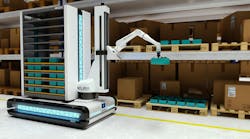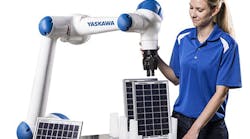Automation Technology Expo West
The dynamics of the robot industry are changing. New entrants and customer types are expanding the market, and new applications, such as collaborative robot palletizing, are creating new opportunities. Last month at the Automation Technology Expo (ATX) West in Anaheim, California, I had the chance to experience a recent collection of design and manufacturing technologies. From custom automation and assembly to control software, an array of valuable information was presented to nearly 20,000 attendees from 2,200 solution providers over a three-day period.
Maintaining Flexible, Safe and Efficient Operations
The first day of the conference, as part of the Smart Manufacturing Innovation Summit, I had the privilege to speak about “The Role of Collaborative Robots in Distributed Manufacturing Systems.” Collaborative robots will play an integral part in the transformation of manufacturing automation and supply chains, and it is important for companies to rethink their manufacturing strategies to maintain flexible, safe and efficient operations.
Because of increasing product individualization, shorter product life cycles and various market demands, production inefficiencies continue to thrive among our innovative landscape. To effectively manage the uptick in manufacturing complexity, more companies are turning from centralized to distributed manufacturing. This promising approach has a keen focus on production layout, maintaining a network of regionally dispersed manufacturing facilities intertwined with workstations that are managed by empowered employees and coordinated by smart technologies.
The Benefits of Distributed Manufacturing Systems
Manufacturers that utilize a distributed manufacturing system (DMS) often experience greater flexibility of production processes, which is key to lowering supply chain costs and meeting increased consumer demands. Automation advancements, like the implementation of collaborative robots (cobots) on the factory floor, further the argument for distributed manufacturing. Human-robot collaboration (HRC), where a cobot shares a common workspace with a human operator to efficiently carry out a defined task, is the basis for future intelligent production.
The use of HRC is quickly changing assembly operations. The most difficult, dirty and tedious tasks, that were previously performed manually, are now being performed by cobots in an ergonomic and efficient way. This combination of advanced automation with human ingenuity has the potential to help manufacturers, no matter the industry or size, to create a highly productive workforce. However, based on attendee demographics at ATX West, small to medium enterprises (SMEs) are especially noticing the value in a new generation of lightweight robots that can be easily programmed to work safely in close proximity to people.
From assembly, packaging, palletizing and dispensing, to machine tending and lab analysis, human-robot collaboration provides easy and safe automation for many applications. The economic benefits derived from HRC can help companies achieve higher throughput, increased quality, greater yields, material handling metrics improvement and labor cost savings. Combining smart manufacturing methods with human-robotic process automation gives manufacturers the ability to create factories that are less prone to disruption, capable of managing diverse products and demands.
The Future of Human-Robot Collaboration in DMS
The positive feedback I have received from the Automation Technology Expo has been encouraging. Large enterprises like Tesla, SpaceX and Future Faraday are showing interest in a new generation of robotic automation, while SMEs are doing the same. The boundaries of automation are still rigid and certain limits need to be redefined for human-robot collaboration in distributed manufacturing systems to reach its full potential. However, the interest for DMS is growing, prompting the improvement of layout planning and the formulation of new simulation algorithms in the year to come.
Bernardo Mendez is Senior Product Manager at Yaskawa Innovation, Inc.










